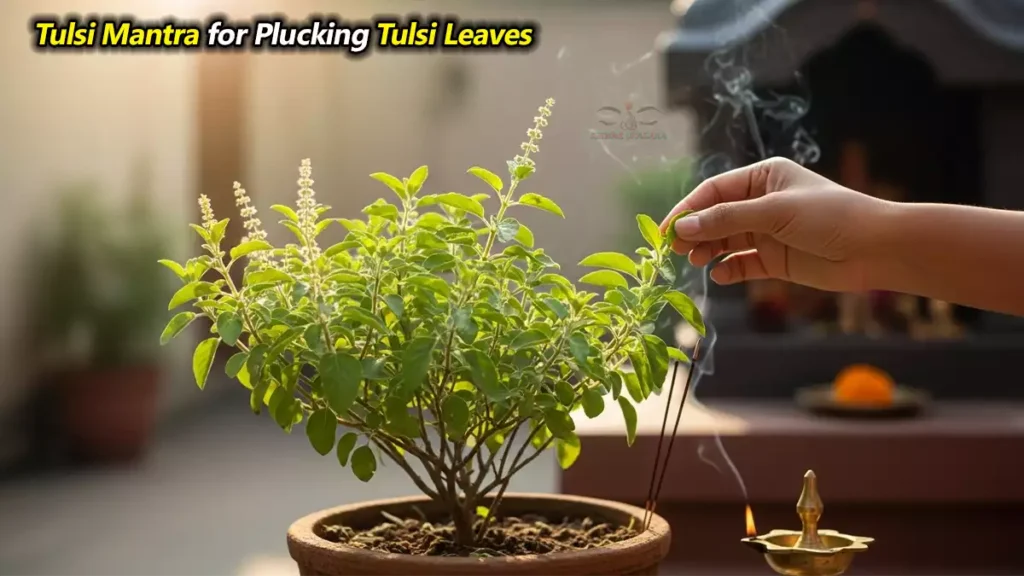Rules for Plucking Tulsi Leaves: Tulsi, also known as Holy Basil, is one of the most sacred plants in Hinduism. Revered for its spiritual significance and healing properties, Tulsi is often worshipped daily in many Indian households. However, plucking Tulsi leaves is not a casual act—it is a sacred ritual that should be done mindfully, with reverence and respect. One essential aspect of this ritual is reciting a Tulsi plucking mantra before taking the leaves.
In this article, we’ll explore a simple Tulsi mantra you can chant before plucking its leaves and understand why this act carries such deep spiritual meaning.

Why Is Tulsi Considered Sacred?
Tulsi is believed to be the earthly manifestation of Goddess Lakshmi and is intimately associated with Lord Vishnu. Offering Tulsi leaves to Lord Vishnu or Krishna is said to bring immense spiritual merit and divine blessings. Because Tulsi is considered a living goddess, every interaction with the plant—especially plucking its leaves—should be done with care, devotion, and spiritual awareness.
The Right Time to Pluck Tulsi Leaves
Before learning the mantra, it’s important to follow traditional guidelines for when and how to pluck Tulsi leaves:
- Pluck only in the morning, after taking a bath.
- Always use your right hand and gently remove leaves along with the petiole (small stem).
- Avoid using fingernails—use fingertips respectfully.
- Offer gratitude to the plant before and after plucking.
Days and Times When Plucking Is Prohibited
Plucking Tulsi leaves is not recommended during certain spiritually sensitive times:
- Dvādashī (12th lunar day)
- Purnima (Full Moon) and Amavasya (New Moon)
- Evenings and after sunset
- Sankranti (solar transition days)
- Sundays
Important: Never break or damage Tulsi branches. It is considered a serious offense in Hindu tradition.
Mantra for Plucking Tulsi Leaves
Before you pluck Tulsi leaves, recite this traditional mantra with devotion and folded hands:
“Om Tulasyamritajanmasi sada tvam Keshava priya |
Keshavartham chinomi tvam varada bhava shobhane ||
Tvadanga-sambhavaiḥ patrair pujayaami yatha Harim |
Tatha kuru pavitrangi kalau mala-vinashini ||”
English Meaning:
O Tulsi, born from nectar, ever dear to Lord Keshava, I pluck your leaves for His worship. O beautiful goddess, please bless me. With the leaves that have sprung from your divine body, I worship Lord Hari. O sacred one, please purify me in this age of Kali and remove my sins.
This mantra is a gentle request for permission from the Tulsi plant, ensuring that the leaves are taken respectfully and used only for sacred purposes like worship or preparing prasad.
How to Pluck Tulsi Leaves Correctly
Here’s a step-by-step guide to follow:
- Take a bath and wear clean clothes before approaching the plant.
- Stand facing east or north near your Tulsi plant.
- Chant the above mantra with devotion and folded hands.
- Use your right hand to gently pluck the leaf (never the branch).
- Place the leaves and flowers (manjari) in a clean, sacred vessel.
- Use them immediately in puja or offering to the deity.
Spiritual Significance of the Mantra
In Sanatan Dharma, plants are considered conscious beings. The act of reciting this mantra before plucking Tulsi leaves transforms a simple daily action into a spiritual offering. It deepens your connection with nature, fosters mindfulness, and honors the divine feminine energy residing in the plant.
Spiritual Benefits of This Practice
- Brings purity and peace to the home
- Enhances your connection with Lord Vishnu and Krishna
- Helps remove negative energies and impurities
- Promotes discipline, humility, and devotion
- Encourages respect for nature and all living beings
Final Thoughts for Rules for Plucking Tulsi Leaves
Plucking Tulsi leaves may seem like a small gesture, but when done with the right mantra, at the right time, and with sincere devotion, it becomes a sacred ritual that draws divine grace. Reciting the Tulsi Patra Chayan Mantra is not just about asking for permission—it’s about aligning your actions with spiritual consciousness.
So the next time you approach your Tulsi plant, treat her not just as a plant, but as a goddess. Offer your prayer, speak the mantra, and invite her blessings into your life.
